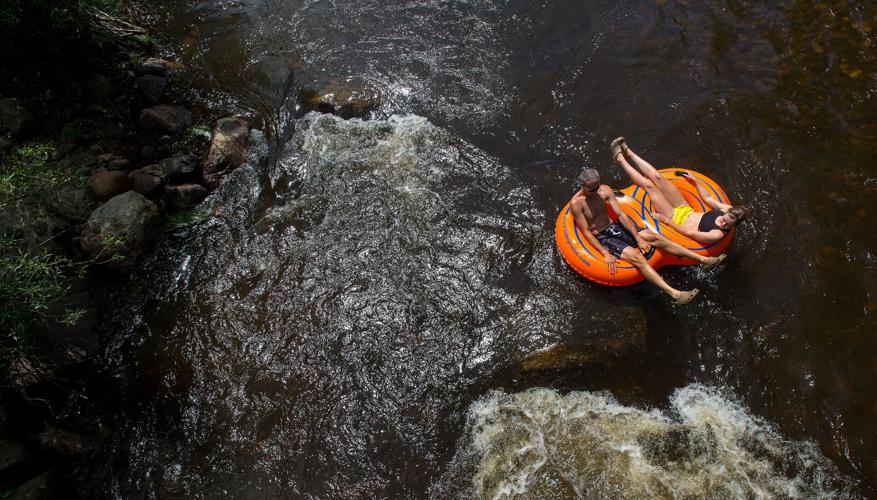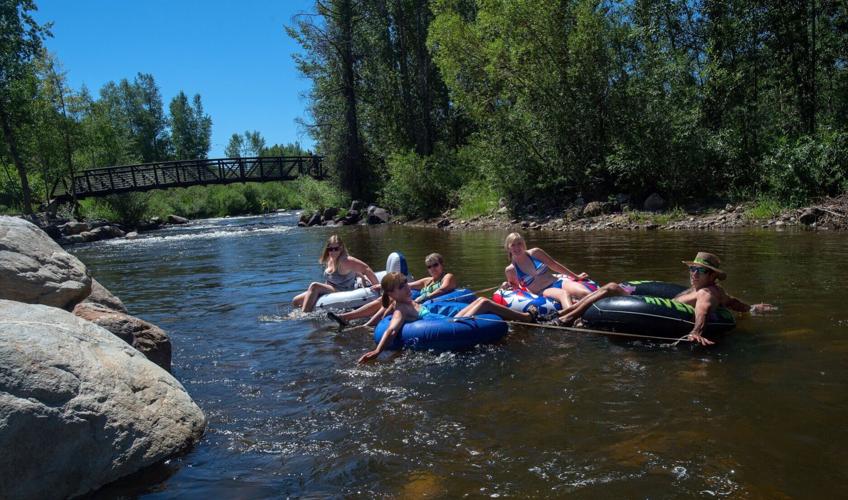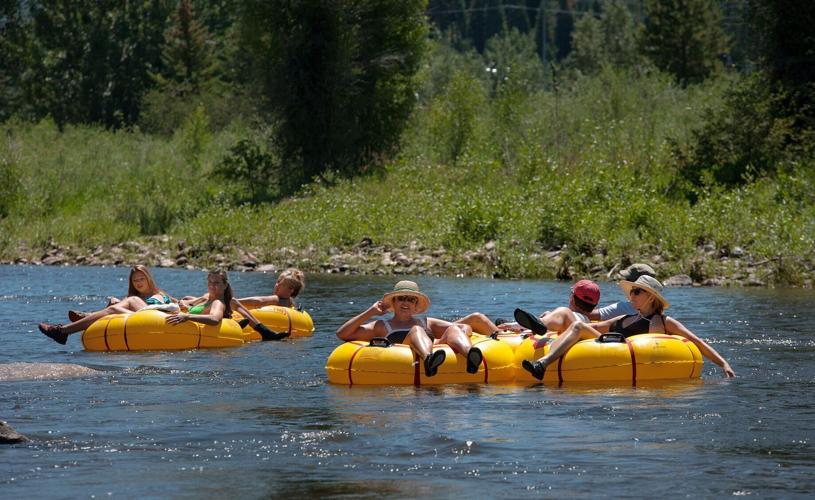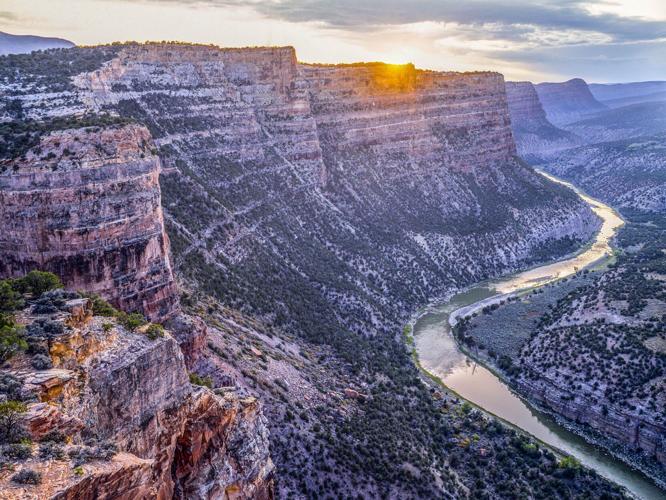Protecting the Yampa: Unique fund in northwest Colorado celebrates 5 years in service to the river
While it’s a hot, dry, wildfire-causing summer in Colorado, at least one basin in the state is blowing out the candles for a unique cavalry riding in to help keep water in its river.
Coming off its fifth-year anniversary, the Yampa River Fund provides grants to projects that protect the water, wildlife habitat, and recreational opportunities of the Yampa River in northwest Colorado.
Founded by The Nature Conservancy and now managed by Steamboat Springs-based nonprofit Friends of the Yampa, the fund’s mission is to enhance water security for local communities, agriculture, and environment; support a healthy, flowing river by enhancing low flows through water leases; and restore riparian and in-channel habitat. Since its inception, it has allocated nearly $1 million to 23 projects throughout the basin, awarding an average of $200,000 per year.
“The Yampa is one of the most important tributaries in the whole Colorado River Basin,” said Nancy Smith, who spearheaded The Nature Conservancy’s launch of the fund as its then-director of the group’s Colorado Water Program. “It’s the last major tributary that is still relatively free-flowing and functions as nature intended.”
It’s a good year to have such a tool in place. According to the U.S. Drought Monitor, as of mid-July much of the southwest portion of the state is experiencing extreme drought conditions, while its northwest corner where the Yampa runs is in severe drought. The Yampa River Fund was designed for just such a scenario, providing a sustainable funding source for protecting and enhancing its flows.
Smith, now The Nature Conservancy’s Colorado River Basin conservation director, added that while The Nature Conservancy played a role in a similar fund set up for Colorado’s Poudre River, the Yampa fund was the first one it spearheaded.
“The Yampa has always been a high priority for us and we’ve been working in that basin for decades,” she said. “Creating the Yampa River Fund there was a natural extension of our decadeslong commitment to its community and river.
“The local community really cares about the Yampa and has been working together very effectively to help protect it. This collaboration made it a slam dunk for us to create the fund. We got together with the community to set a vision and pathway for the river’s future and raise money to achieve it.”
The idea has prompted a flood of new support for the river.
“The Colorado Water Trust and The Nature Conservancy kept going back to the same donors for buying water for the Yampa from Stagecoach Reservoir,” said the fund’s inaugural manager Andy Baur. “They decided they could create a more permanent and sustainable funding source based on [The Nature Conservancy’s] river fund experience from around the world.”
Local support came quickly. Outdoor companies, such as Smartwool and Big Agnes, donated seed funding, as did Steamboat Ski Resort, which uses the river for its snowmaking. Mountain Tap Brewery, just a block away from the river — whose owner, Rich Tucciarone, regularly swaps his brewer’s mash paddle for a SUP paddle to surf the river — even brewed a special Yampa River Fund beer in its honor, the aptly named Free Flow IPA.
Governed by a 21-member board representing local governments, community and statewide nongovernmental organizations, businesses, water providers, and irrigation districts, the fund eclipsed its initial five-year goal of $5 million in just a year and now tops $6 million, interest from which supports its annual grants.
“It’s exceeded all our expectations,” said Smith. “It’s a real testament to the fact that people up there love the Yampa and want to conserve and protect it.”
The Nature Conservancy has worked with more than 200 partners in 13 countries, from Colombia to Kenya, to create 43 water funds, including 14 such funds in the U.S. All vary in context, scale, and scope, from New Mexico’s Rio Grande Water Fund to Maine’s Sebago Clean Waters Fund. But none target the last remaining free-flowing waterway to the Colorado River Basin, helping provide what it needs most — water.
One critical partner in the fund’s founding was the Colorado Water Trust, which had already implemented a successful water release program from Stagecoach Reservoir, owned and managed by the Upper Yampa Water Conservancy District. Facing severe drought in 2012, with flows dropping to just 5% of normal, the state tasked the Colorado Water Trust “to purchase and release water from an upstream reservoir to increase flows during a critical time of need.”
The project restored 4,000 acre-feet to the river that summer in increments of 26 cubic feet per second. The restored flow was protected through the 5½-mile stretch through town, with its benefits continuing downstream. That effort has continued every season-in-need since, with monies from the fund providing a sustainable funding mechanism to keep that water-buying program going.
The Colorado Water Trust now has a 10-year contract with Upper Yampa Water Conservancy District to strategically release up to 5,100 acre-feet from Stagecoach Reservoir to benefit the environment and other water users. It can also use grant funding along with backing from the Colorado River Water Conservation District to release up to 2,000 acre-feet from Elkhead Reservoir downstream.
“It’s incredibly helpful to have a reliable source of matching funds on any given year to purchase water,” said Colorado Water Trust Programs Director Blake Mamich. “Before the YRF, that sort of funding stability didn’t exist. The amount of water that could be released on a given year was much more constrained by annual fundraising. Now, we’re much more prepared to be able to release the full amount of water allotted to us to benefit the river and the community.”
Mamich added that it’s also a distinctive funding source.
“As far as a fund set up to support water purchases, the Yampa River Fund is unique as far as I know,” he said. “There aren’t any other sources of perpetual funding specific to environmental releases in a given basin that I am aware of.”
The releases benefit both the Yampa’s ecological health, as well as the broader community by reducing the number of days Steamboat Springs enacts river closures due to low flows and increased temperatures, which affect dissolved oxygen levels for fish. (Such a closure went into effect this summer on July 13.)
A 2022 economic analysis conducted by nonprofit American Whitewater found that the releases created 30 additional days of flows above 85 cubic feet per second, generating $500,000 in economic activity in the region. They also help the city’s commercial tubing operators remain open and increase revenues for riverside businesses along Yampa Street.
“It contributes to the overall well-being of the community by keeping water in the river when it’s needed most,” Mamich said.
The fund also supports other projects benefiting the river. In 2024, it awarded five grants totaling $204,125 to river-bettering projects, including floodplain planning, bank stabilization, irrigation improvement, and riparian restoration endeavors.
“Word has gotten out and we are seeing a broad range of important projects applying for our grants,” said fund manager Mike Robertson. “This critical funding source can help facilitate the types of projects that improve the health of the river to benefit everyone.”
A river in peril?
Stretching 250 miles from its birthplace in the Flat Tops Wilderness Area to its confluence with the Green River in Dinosaur National Monument, the Yampa and its natural hydrograph is as unbridled as the wild horses in nearby Brown’s Park, which once housed Butch Cassidy’s Hole in the Wall Gang.
It changes from a trickle in fall to a raging torrent come spring, cycling through every level in between. These fluctuations support everything from unique riparian habitat and endangered fish reliant on their peak flows to such human uses as agriculture, municipal use, and recreation. It also serves two major coal mines, a power plant, seven towns, and snowmaking operations for Steamboat Ski Resort, all while helping fulfill the state’s water obligations to downstream users as outlined in the Colorado River’s 1922 Water Compact.
Throw in iconic Yampa Canyon in Dinosaur National Monument at its tail end and it’s everything you could want in a river and more. “It’s the lifeblood of this valley and truly a precious resource,” said the fund’s founding manager, Andy Baur.
Yet not everything is honky-dory in Yampa-land.
It’s the last major basin in the state with unappropriated water, meaning all eyes are on it. With tunnels, pumpbacks and reservoirs already siphoning Western Slope water to the growing Front Range, and drought-ridden states downstream clambering for more, there’s a bounty on the Yampa’s snowmelt, from municipalities across the Continental Divide to oil, gas and mining operations and thirsty states downstream. It’s also started experiencing issues that have long plagued other rivers like over-appropriation, calls and water shortages.
While the Yampa has already fended off plenty of feuds for its lifeblood — from escaping the Echo Park Dam in 1956, marking one of the conservation world’s first major victories, to pumpback projects and other diversion schemes — it’s now facing perhaps its biggest threat: climate change.
In August 2021, a water shortage was declared on the Colorado for the first time since the Compact was inked a century ago, marking one of the driest years in the West on record. A Nature Climate Change study reported that a 20-year “megadrought,” which began in 2002, represents the driest 20-year period in at least 1,200 years.
The Colorado’s flows have dropped 20% since 1906 and a recent Colorado Climate Report maintains that they’ll shrink by 5%-30% over the next 30 years. Global warming, it adds, has raised Colorado’s annual average temperature by 2.3 degrees since 1980, with it estimated to rise another one to four degrees by 2050. Meanwhile, demand has continued to grow, to where it now exceeds the river’s annual flows.
In Steamboat, a report prepared for the city by Summit Economics shows a trend toward earlier snowmelt and more severe soil-moisture conditions; peak runoff has already shifted one to four weeks earlier over the past 30 years, with projections showing snowpack declining 5%-20% by 2050. All this makes the efforts of the Yampa River Fund even more important.
“The Fund has worked great since its inception, with another successful season last year,” said board chair Jackie Brown. “Our partnerships, financial support, and high caliber applicants demonstrate our important role in the basin. We continue to plan for how we can meet the needs of a basin facing a multitude of water challenges at a local level.”
It’s this local level of support that makes the program hold water.
“The Yampa River Fund is a critical funding source for keeping environmental flow releases in the Yampa, whether we’re using the instream flows loan program or not,” added Upper Yampa Water Conservancy District’s public information manager Holly Kirkpatrick. “The fact that we have so many partners in our community that have come together to help develop and fundraise for a solution like this is pretty unique. I don’t think you find that in other river basins.”
About the only thing the fund can’t do is increase the size of the pool, which is up to Mother Nature.
“No matter how great it is, the fund can’t create water,” added Smith. “But it can give a community like Steamboat another tool in its toolbox to help protect their local river. It’s a true testament to what an amazing water community exists there.”
Info: yampariverfund.org.








